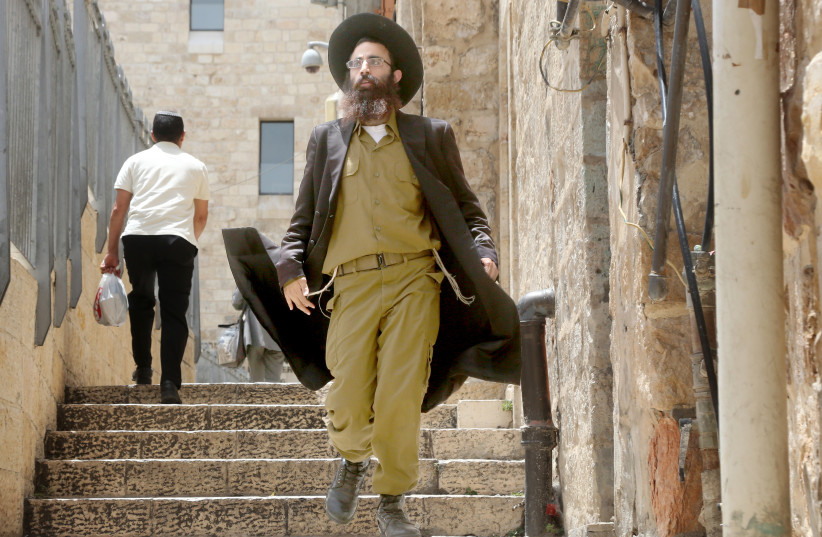On Saturday night, October 21, the IDF Spokesperson’s Unit announced in a press briefing that: “We are seeing a growing trend of members of the haredi public submitting requests to be drafted and volunteer in the IDF. More than 2,000 inquiries have been received from members of the haredi public so far. We are preparing special plans for this, and from Monday they will be drafted.”
The trend described by the IDF spokesperson is strongly felt on the streets of haredi (ultra-Orthodox) communities, and is greatly worrying the leaders of the haredi mainstream. The Haredi newspaper Yated Ne’eman quoted Rabbi David Cohen, one of the heads of Yeshivat Hevron (one of the flagship yeshivot of the Lithuanian Haredi community), as rejecting outright the calls for yeshiva students to volunteer: “The heart bleeds for the talk heard from the margins of our camp, claiming that at this time of crisis, when all Israel is in danger, we should go help and should exit the walls of the yeshiva. Anyone who says such things has no knowledge of what Torah is, what the Jewish people is, or what yeshiva students are, nor of the concept ‘The Torah, the Holy One, and Israel are one” (Zohar 3:73a)..’”
But a quick browse through the pages of history tells us that some of the greatest rabbinical leaders and heads of yeshivot from previous generations did not agree with this opinion of Rabbi Cohen. At critical junctures for the Jewish nation – for example, when the very existence of the pre-state Jewish Yishuv in the Land of Israel was in the balance – the rabbis encouraged their followers to volunteer and to contribute to the success of the struggle, whether in combat or on the home front.
Ahead of the outbreak of the War of Independence, on May 10, 1948, an agreement was signed between the “Command Center for National Service” of the nascent IDF and various rabbis and heads of yeshivot, including even the leader of the separatist Edah HaChareidis. The first section of the document excused yeshiva students from the duty of service in principle, but as a temporary emergency measure it was agreed to hold training days for all yeshiva students in Jerusalem (with the exception of a small number of gifted students who received a special exemption).
According to the agreement that was drawn up, yeshiva students aged 17–22 would train in the use of weapons and would be called on if necessary, while those aged 23 and over would serve in guarding and defense roles in special religious units. Following the signing of this agreement, the Tuvia Battalion was established, in which Haredi yeshiva students served mainly in fortification work.

HAREDIM ALSO played an active role in the Six Day War. According to an article by Menachem Keren-Kratz, thousands of haredi soldiers served in the war of 1967, making up around four percent of the total number of soldiers enlisted (as estimated by Keren-Kratz). These included members of the Old Yishuv in Jerusalem, members of the many hassidic communities that were still present in Tel Aviv, residents of Haredi agricultural villages, and graduates of yeshivot in Bnei Brak.
Some of them served with the IDF Military Rabbinate, identifying bodies, and some served as regular combat soldiers. The yeshiva students who remained in Jerusalem during the heavy bombardments would go down into basements that had been prepared in advance and continue to study and recite psalms. Some of them donated blood, and others volunteered in hospitals and in distributing food to the needy.
I do not have data about the total number of haredi soldiers who served in the Yom Kippur War, but we know that almost half of all the soldiers who have been killed over the years in the Haredi Nahal Battalion fell in the Yom Kippur War.
Why did haredi society in Israel change in the 1970s?
So what has changed? As Yair Halevy and Menachem Keren-Kratz have both noted, the 1970s marked a watershed in the relations between haredi society and the State of Israel. Halevy and Keren-Kratz differ on the reasons for this development, but it is widely agreed that Haredi society was more involved in Israeli society up to the 1970s, in terms of its geographical distribution, its participation in the workforce, and its identification with the state and its symbols.
The impression gained from looking at haredi society today, is that the pendulum – as described by Halevy in his doctoral dissertation – is now swinging back toward greater integration, at least for parts of haredi society. These segments are participating more and more in the labor market and in higher education, and even identify as “Israeli haredim.”
In many ways, the “modern Haredi” phenomenon has not been able to transform itself into a real movement until now. It has not produced a system of flourishing institutions, active political leaders, and a strong religious leadership. But in recent years, it appears that things are finally falling into place. Time will tell whether the recent events prove to be the spark that lit an important new fire, or simply a spark that flickered for a short time before fading out.
The writer is a research assistant in the Ultra-Orthodox in Israel Program at The Joan and Irwin Jacobs Center for Shared Society of the Israel Democracy Institute, and a doctoral student in Jewish philosophy at The Hebrew University of Jerusalem.
A variation of this article first appeared in Hebrew in Makor Rishon.
